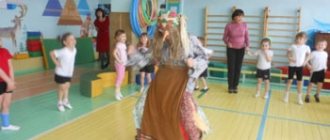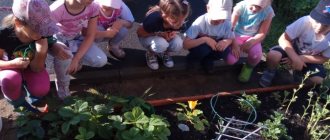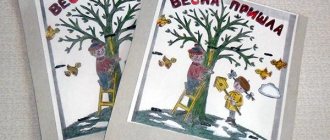Forms and methods of work on environmental education in preschool educational institutions
Kuzenkova
Forms and methods of work on environmental education in preschool educational institutions
Consultation for the pedagogical council on the topic: “ Forms and methods of work on environmental education in preschool educational institutions ”
Environmental education of preschool children has important social significance for the whole society. At this time, the foundations of ecological culture are laid in the human personality, and at the same time, a significant part of the country’s adult population— workers in the field of preschool education and parents of children— .
Methods of working with children on environmental education.
methods are ways of joint activities between educators and children , during which the formation of knowledge , skills and abilities is carried out, as well as the development of attitudes towards the world around us.
teaching methods are widely used in environmental education : visual, practical, verbal.
Visual methods include observation, looking at paintings, demonstrating models, films, videos, and presentations. Visual methods most fully correspond to the possibilities of cognitive activity of preschool children and allow them to form vivid , concrete ideas about nature.
Practical methods are games , elementary experiments and modeling. The use of these methods allows the teacher to clarify children's ideas, deepen them by establishing connections and relationships between individual objects and natural phenomena, systematize the acquired knowledge, and train preschoolers in applying knowledge.
Verbal methods are stories from the teacher and children , reading works of art about nature, conversations. Verbal methods are used to expand children's knowledge about nature, systematize and generalize it. Verbal methods help to form in children an emotionally positive attitude towards nature. When working on environmental education of children, it is necessary to use different methods in a complex and correctly combine them with each other. The choice of methods and the need for their integrated use are determined by the age capabilities of the children, the nature of the educational tasks that the teacher . For example, the formation of knowledge about the way of life of a rabbit is impossible without observations; children learn about ways to care for indoor plants in the process of work; about the properties of snow and ice - during experiments or games. Knowledge about wild animals is formed while reading or telling a story to the teacher .
Forms of organizing work with children on environmental education
Organized educational activities (classes)
Classes are the leading form of organizing work to familiarize children with nature. They allow the teacher to form knowledge about nature in a system and sequence, taking into account the age characteristics of children and the natural environment.
Under the guidance of the teacher, develop in the classroom and develop basic cognitive processes and abilities. Classes provide an opportunity to clarify and systematize children’s personal experience, which they accumulate during observations, games and work in everyday life.
Excursions. Excursions are one of the main types of classes and a special form of organizing work on environmental education . Excursions are conducted outside the preschool. This is a kind of outdoor activity.
The advantage of excursions is that they allow children to become acquainted with objects and natural phenomena in a natural setting.
On excursions, children get acquainted with plants, animals and at the same time their living conditions, and this contributes to the formation of primary ideas about the relationships in nature, as well as the development
Ecological holidays and leisure activities . The pedagogical meaning of holidays and leisure is to evoke in children a positive emotional response to their “natural”
content.
The scripts for these events use material that children are familiar with. More often than holidays, leisure activities are held on a variety of topics - they are organized by the teacher .
Environmental actions . An effective means of solving the problems of environmental education of preschool children are environmental actions . Environmental actions are event-significant events aimed at preserving the environment. During their implementation, preschoolers receive natural history knowledge, they develop environmental culture skills and an active life position. The promotions also serve as environmental propaganda among parents, who become active helpers.
Introducing children to nature in everyday life. Observations during classes and excursions are carried out in close connection with work in everyday life. Teachers widely use walks for environmental education of children . They provide an opportunity for children to accumulate ideas about natural phenomena that occur over a long period of time. Teachers introduce pupils to the daily changes of nature according to the seasons in the kindergarten area, organize a variety of games with natural materials - sand, clay, water, ice, etc. Children accumulate sensory experience, cultivate curiosity and observation.
And also in kindergarten groups it is necessary to create an appropriate subject-development environment, which provides for the construction of a variable developmental space, focused on the possibility of children freely choosing materials and participants in joint activities. It should be accessible, that is, provide students with free access to materials , manuals, and natural objects. Safe, i.e. all its elements must meet the requirements for ensuring reliability and safety of their use. And include not only a natural corner, but also a center of cognitive activity for experimenting with various materials, observing natural phenomena and inanimate objects.
Children's work in nature. Varied work in nature brings children a lot of joy and contributes to their all-round development. In the process of work, a love for nature , a careful and caring attitude towards it is cultivated. Children develop an interest in work activity and a conscious, responsible attitude towards it. Working in nature, children become familiar with the properties and qualities, states of natural objects, and learn ways to establish these properties. In the process of working in nature, children develop knowledge about plants and animals. Children observe plants, practice labor skills (watering plants, loosening, collecting seeds and harvests, etc.)
.
This work has a great influence on the development of hard work , independence and mutual assistance.
Working with parents is one of the most important forms of environmental education . A full educational effect is achieved when the kindergarten and the family act in the same direction. Therefore, working with parents is one of the most important forms of environmental education . When working with parents on environmental education of children, various forms :
• Questionnaires, conducting surveys
• Parent meetings, master classes, consultations;
• Joint leisure activities, holidays, KVNs, quizzes, etc.
• Participation in thematic exhibitions, competitions.
• Involving parents in joint work with their children on the kindergarten site, landscaping the kindergarten territory;
• Release of newspapers, photo newspapers, environmental albums , posters,
Such work with families helps to improve the pedagogical culture of parents, develop the correct forms of interaction between kindergarten and family, and helps create a more favorable environment in the family.
Conclusion. Thus, the formation of environmental consciousness , ecological culture is a long process, the beginning of this path is preschool childhood. The formation of the principles of ecological culture is the formation of a consciously correct attitude directly towards nature itself in all its diversity, towards the people who surround and create it. And in conclusion, I would like to say that the most important thing in environmental education is the personal conviction of the teacher, the ability to interest and awaken in children and their parents the desire to love, cherish and protect nature.
Methods of environmental education for preschool children
Bibliographic description:
Ivanova, V.V. Methods of environmental education for preschool children / V.V. Ivanova. — Text: direct // Education and upbringing. - 2021. - No. 4 (19). — P. 17-19. — URL: https://moluch.ru/th/4/archive/101/3536/ (access date: 11/21/2021).
Everyone knows about the beneficial effects of nature on humans. The organization of useful activities for children, according to a number of authors (V.G. Gretsov, E.N. Nikolaev, P.G. Samorukova, etc.), is the basis for a conscious, careful attitude towards nature. This is how we can determine the boundaries of the most important problem of environmental education of children in our time. The problem of environmental education and upbringing is one of the most pressing today. In the system of continuous environmental education, the initial link is preschool childhood. During this period, the formation of the most important qualities of the human personality takes place, and the foundations of an ecological culture are laid. Already from preschool age, it is necessary to give children the idea that a person needs an environmentally friendly environment.
Classical pedagogy distinguishes two concepts - “teaching methods” and “upbringing methods”; their theoretical consideration will help to define and characterize the methods of environmental education of preschoolers.
Leading domestic teachers (I. Ya. Lerner, N. M. Skatkin, Yu. K. Babansky, etc.) consider teaching methods as a system of sequential interconnected actions of the teacher and student. At the same time, any teaching methods are characterized by three characteristics: the purpose of training, the method of mastering the content, and the interaction of participants in the process.
Researchers, both ours and foreign ones, note the general development of the theory of teaching methods, which results in numerous and different bases for their classification [3].
Yu. K. Babansky in his classification identifies three groups of teaching methods: methods of organizing and implementing educational and cognitive activities; its stimulation and motivation; her control and self-control. The term “educational-cognitive activity” precisely implies the joint activity of the teacher and students, in which the teacher performs educational actions, and the students perform cognitive ones.
According to S.N. Nikolaeva, preschool pedagogy, to an even lesser extent than school pedagogy, explores methods of raising and teaching children. S. N. Nikolaeva gives the following definition of the pedagogical method - this is a method of influencing an adult on children through joint activities.
There is no unified classification of methods in environmental education.
In the environmental education of children, the classification of methods (visual, verbal, practical) is widely used. Objects and natural phenomena that a child must learn require the use of a variety of methods.
When introducing children to nature, it is necessary to use all methods in a complex, and at the same time correctly combine them with each other.
The method of environmental education is a science that studies the features and patterns of organizing pedagogical work with preschool children. The main goal of environmental education of children is to teach the child to develop knowledge of living nature [1].
The main method in environmental education is the visual method.
Visual methods contribute to the formation in children of clear ideas about the world around them, play and work activities, and the development of perception. Visual methods are observational methods that stimulate children's interest.
Observation is a purposeful, systematic perception of objects and phenomena of the surrounding world. By organizing observations in nature, the teacher solves the following problems:
- Forms children's knowledge about nature;
- Develops interest;
- Develops aesthetic feelings. [4]
The teacher uses various types of observation.
Recognizing observation.
It is used to get acquainted with a new natural phenomenon. In the process of discriminating observation, children learn to distinguish color, shape, size, and spatial arrangement of parts.
Long-term observation.
For example, you can watch the growth of onions in a jar of water. During these observations, intelligence, observation, comparisons develop, and they learn to analyze.
Observation begins with the selection of an object. To arouse children's interest, the teacher uses poetry, small forms of folklore, and excerpts from works of art.
Visual methods contribute to the formation in children of clear ideas about the world around them, play and work activities, and the development of perception.
Verbal methods. When using verbal methods, the teacher must take into account the ability to understand speech, long-term voluntary attention and concentration on content [2].
For example: while walking, the children saw ants working. "What are they doing?" - the children ask. The teacher offers to look first, and then, during the observation process, talks about ants.
- Story - used to attract children's attention.
The next group of methods are practical methods. Practical methods include: play.
The basis for the classification of games was laid by J. F. Lesgaft. He discovered a system of outdoor games and developed their methodology.
Play is a method by which children get acquainted with the world around them. When getting acquainted with nature, the following types of didactic games are used.
Subject games are games using different cones, seeds, leaves, etc.
Tabletop - printed - develop logical thinking (“Berries and Fruits”, “Mushrooms”, “Loto”).
Word games - oral questions about nature to children (“When does this happen?”, “Who flies?”, etc.)
Creative games: construction games, which help children to understand the quality and properties of natural objects (sand, cones, snow, clay).
Outdoor games: children imitate the habits of animals. (“The Mother Hen and the Chicks”, “Wolves and Sheep”, “Sunshine and Rain”)
Work. It is used in everyday care of plants in a corner of nature.
While developing labor skills, at the same time it is necessary to consolidate knowledge about nature. For example: Before sowing, consider the seeds (shape, size, color).
One of the important conditions for the implementation of an environmental education system in a preschool institution is the correct organization of the developmental subject environment.
Environmental education of preschool children is an important component. This takes into account the age of the children and the essence of the phenomenon or natural object being studied. And the most important thing is to evoke an emotional response in children and a desire to continue and get acquainted with environmental activities.
I am deeply convinced that it is necessary to instill in children a love of nature from a very early age.
Literature:
- Nikolaeva S. N., Komarova I. A. Story games in the environmental education of preschool children. Game-based learning situations with toys of various types and literary characters6 A manual for teachers of preschool institutions. - M.: GNOM and D. 2003. 100 p.
- Nikolaeva S.N. Methods of environmental education of preschool children / Nikolaeva S.N. - M., 2001.
- Ryzhova N. A. Environmental education in kindergarten / Ryzhova N. A. - M. 2000.
- Serebryakova T. A. Environmental education in preschool age / Serebryakova T. A. - M., 2006.
- Surkina S. A. Environmental education of preschool children: textbook Surkina S. A. - Saratov: Publishing House "Saratov Source", 2011. - 103 p.
Key terms
(generated automatically)
: child, the world around us, environmental education of children, preschool age, play, nature, environmental education, cognitive activity, labor activity, environmental education.




